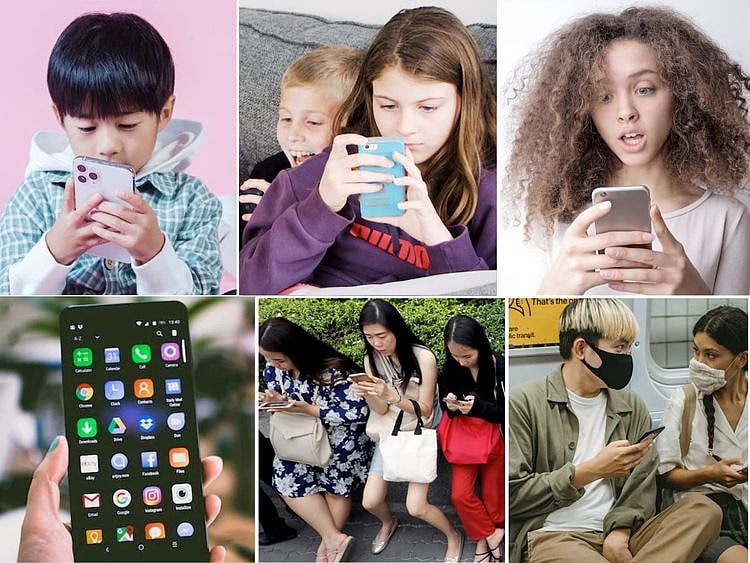Global peril: Zombie scrolling, doom scrolling, infinite scrolling (here's how to break free)
Invented in 2006, most sites or apps use an infinite scroll algorithm for loading no end

Have you been "doom scrolling" lately? Or is it the first time you heard about it?
It turns out it's something we've all probably been doing lately.
Doom scrolling, aka zombie scrolling, is a relentless dive into social media feeds — a trap that wastes away the lives of millions, possibly billions daily.
It feels harmless, until it isn't.
We are producing millions of lonely, addicted, purposeless men and women.Dr Ashok Khanojia, psychiatrist
Psychiatrist Dr Ashok Khanojia (aka Dr. K) explains the power of this addictive habit.
What's doom scrolling?
Doom scrolling is a trap, he warns, that's eating into people's mental health.
"We are producing millions of lonely, addicted, purposeless men and women," said Dr. K, a Harvard-trained psychiatrist, author, and co-founder of the mental health platform Healthy Gamer.
What's behind it?
For one, it is fuelled by a "negativity bias" which the human mind is wired to do, which then fuels anxiety, exhaustion, and emotional burnout.
Dr K. uses his blend of scientific neuroscience and personal experience to help individuals, particularly young people and gamers, navigate mental health challenges.
His background includes overcoming a severe video game addiction in his youth and a career in psychiatry that focuses on the impacts of technology and digital culture on mental well-being.
Who invented doom scrolling, aka infinite scrolling?
Infinite scrolling (also known as endless scrolling, or doom scrolling) was invented by coding genius Aza Raskin in 2006.
He developed this technique to eliminate pagination by continuously loading content as users scroll down the page, allowing them to scroll seemingly forever without clicking.
In the smartphone era, this technique
What did Aza Raskin say about it?
Raskin later expressed regret over the invention.
In 2019, he said he "did not foresee the consequences" and called infinite scrolling "one of the first products designed to not simply help a user, but to deliberately keep them online for as long as possible".
He described the effect as addictive and compared it to "behavioural cocaine," noting that it keeps users coming back repeatedly.
He admitted feeling guilty and highlighted that the business models of big tech companies pressure designers to create such addictive features to increase user time on apps.
I was blind to the incentives ... I was blind to how I was going to get picked up and used not for people but against people.Aza Raskin, inventor of infinite scroll in 2006.
Is it a form of addiction?
Yes.
Research shows infinite scrolling can present accessibility issues and pathways to smartphone and social media addiction due to lack of stopping cues and endless content flow.
By design, it exploits psychological triggers akin to addiction. It operates as a "variable reward system" that keeps users scrolling for random rewards like "likes", new content, or positive feedback, triggering dopamine release similar to addictive behaviours.
"I was blind to the incentives and this is before social media really had started going. I was blind to how I was going to get picked up and use not for people but against people," Raskin told Joe Rogan.
Translation: focusing narrowly on one individual or one company blinds you to the broader, complex system (ecosystem) and how various parts interact and affect each other on a broader scale.
A wider perspective, he explained, is essential to understanding the true impact and ethics of tech at scale.
What studies show
Mental health impact: Studies highlight "zombie scrolling" causes dysregulation of the nervous system, anxiety, depression, brain fatigue ("brain rot"), eye strain, and emotional disconnection. For young people, the negative social comparisons on platforms like Instagram worsen mental health.
Doomscrolling prevalence: A 2024 survey found approximately 31% of American adults regularly doomscroll, with higher percentages among millennials (46%) and Gen Z (51%).
Negativity cycle: Doomscrolling also feeds a cycle where negative news leads people to seek more doom and gloom, exacerbating anxiety and feelings of helplessness. A PMC research (2022) demonstrated how negativity bias operates at an "unconscious level", which increases sensitivity to negative stimuli. The study emphasised that negativity bias is context-dependent and affects both conscious and unconscious cognitive processing, which may explain why people linger on negative information during activities like doom scrolling.
Brain imaging studies Moreover, a 2019 review of multiple psychological and brain imaging studies, confirmed that humans are wired to pay more attention to negative stimuli than positive ones. Why? negative information elicits stronger brain responses, making it more memorable and influential on decisions and behaviours. This bias can lead to increased attention to negative news, often amplified by social media infinite scroll, contributing to phenomena like doom scrolling where users get trapped in consuming mostly negative content.
How to break free
Is it even possible to break free?
Amid the relentless onslaught of visual stimulants offered by the digital age, is there a way out of mental rut from infinite scrolling?
Experts say it's possible.
But it takes some work, i.e. conscious effort.
For one, understanding the dangers and learning how to break free is essential for reclaiming control over your mind.
The long and short: doom-scrolling is linked to negative mental health effects and addiction.
Avoidance strategies focus on mindful use, setting boundaries, and controlling environmental triggers.
Sign up for the Daily Briefing
Get the latest news and updates straight to your inbox
Network Links
GN StoreDownload our app
© Al Nisr Publishing LLC 2025. All rights reserved.